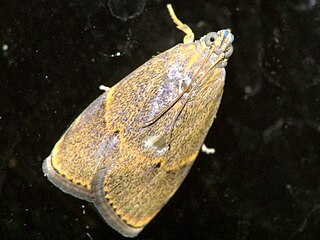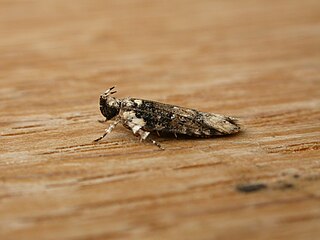Stachyostoma is a genus of moth in the family Gelechiidae. It contains the species Stachyostoma psilodoxa, which is found in Ecuador.

Imma mylias is a moth of the family Immidae. It is native to Sri Lanka, India, the Andaman Islands, the Philippines and Taiwan. It is an introduced species in Hawaii.

Ardozyga sodalisella is a species of moth in the family Gelechiidae. It was described by Francis Walker in 1864. It is found in Australia, where it has been recorded from Queensland and New South Wales.
Stenoma compsocharis is a moth of the family Depressariidae. It is found in Bolivia. The wingspan is about 23 mm. The forewings are white, somewhat sprinkled fuscous in the disc and with the extreme edge of the costa towards the base and a basal dot dark fuscous. There is a small cloudy fuscous spot on the costa at one-fifth, a larger one at two-fifths, and a still larger triangular spot at two-thirds including a whitish costal dot. The stigmata are small, indistinct and dark fuscous, the plical obliquely beyond the first discal. There is a large fuscous dot on the costa at four-fifths, beneath this an angulated transverse series of minute dots. A fuscous dot is found on the costa near the apex, and there is a terminal series of minute indistinct dots. The hindwings are white, with the apical and terminal edge interruptedly grey.
Stenoma injucunda is a moth of the family Depressariidae. It is found in Peru.
Stenoma commutata is a moth of the family Depressariidae. It is found in Brazil.
Antaeotricha paracta is a moth of the family Depressariidae. It is found in Peru and Colombia.
Antaeotricha impedita is a moth of the family Depressariidae. It was described by Edward Meyrick in 1915. It is found in Peru.
Stenoma vaga is a moth of the family Depressariidae. It is found in the Amazon region.
Gonioterma seppiana is a moth of the family Depressariidae. It is found in the Guianas.
Gonioterma choleroptila is a moth of the family Depressariidae. It is found in Guyana.
Stenoma immunda is a moth of the family Depressariidae. It is found in Guatemala, Panama, Venezuela, Ecuador, Peru, Brazil, the Guianas and Trinidad.
Stenoma staudingerana is a moth of the family Depressariidae. It is found in the Colombia, French Guiana and Pará, Brazil.
Antaeotricha fraterna is a moth of the family Depressariidae. It is found in Brazil (Amazonas) and French Guiana.
Antaeotricha phollicodes is a moth of the family Depressariidae. It is found in French Guiana.
Torodora carcerata is a moth in the family Lecithoceridae. It was described by Edward Meyrick in 1923. It is found in Assam, India.
Agriophara lysimacha is a moth in the family Depressariidae. It was described by Edward Meyrick in 1915. It is found in New Guinea.
Antaeotricha mendax is a moth in the family Depressariidae. It was described by Philipp Christoph Zeller in 1855. It is found in Brazil, Panama and Peru.
Antaeotricha notogramma is a species of moth in the family Depressariidae. It was described by Edward Meyrick in 1930. It is found in Brazil (Amazon).

Imma acosma is a moth in the family Immidae. It was described by Alfred Jefferis Turner in 1900. It is found in Australia, where it has been recorded from Queensland and New South Wales.


